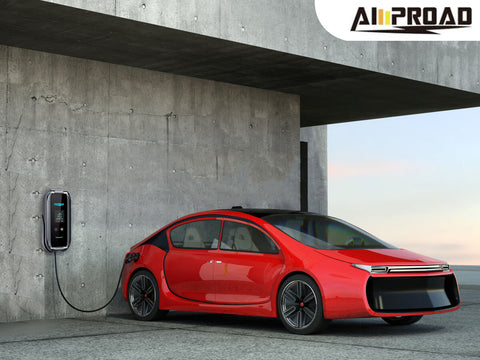
Owning an electric vehicle (EV) brings a new set of questions, one of which might be: "Should I unplug my charger when it's not in use?" Unlike gasoline-powered cars with their straightforward fueling routines, EVs require a different approach to charging. Understanding the benefits and drawbacks of unplugging your EV charger can help you make informed decisions for the long-term care of your battery and your own peace of mind. Let's delve into the factors to consider, so you can confidently navigate the world of EV charging etiquette.
Should You Unplug My EV Charger When Not in Use?
You generally don't need to unplug your home EV charger (EVSE) when not in use. Modern EVSEs and EVs have built-in safety features.
- Minimal Power Draw: When not actively charging, most EVSEs draw very little power, similar to a phone charger.
- Safety Features: EVSEs are designed with safety mechanisms to prevent electrical hazards, even when not actively charging.
- Convenience: Constantly plugging and unplugging the EVSE can be inconvenient and may even wear out the connection over time.
However, there might be minor exceptions:
- Personal Preference: Some users may prefer to unplug the EVSE for peace of mind or to minimize any potential power consumption, even if it's minimal.
- Specific Recommendations: Consult your EVSE and vehicle owner's manuals for any specific recommendations or instructions regarding unplugging the charger.
In most cases, leaving your EVSE plugged in when not in use is perfectly safe and convenient. Choose one best EV home charger that satisfy your needs is important. AMPROAD level 2 home EV charger, including max 40A adjustable portable EVSE, 48A permanent home EV charger, and 40A adjustable EV chaerging home flex, are perfect for home EV charging and on the go.

AMPROAD Home EV Charger Including portable EVSE, Fixed Home EV Charger, and Semi Permanent EV Home Charging Flex
When Should You Unplug Your EV Charger?
Choosing when to unplug your EV charger or leave it plugged in depends on various factors including safety, convenience, and your car’s specific features. Understanding these factors can help you make informed decisions that optimize your charging routine and maintain your vehicle's battery health.
When is it beneficial to unplug my EV charger?
There are certain situations where unplugging your EV charger is advisable to ensure safety and protect your equipment:
- During Thunderstorms: Unplugging your EV charger during thunderstorms is a good precautionary measure. Lightning strikes can cause power surges that might damage your charging equipment or your vehicle’s electrical system. If a storm is approaching, it’s a good idea to unplug your Level 2 charger to prevent any potential harm.
- Extended Parking: If you plan to leave your car parked for an extended period, such as during a vacation, it’s beneficial to unplug the charger once the battery is fully charged. Continuous charging or remaining connected to the charger might lead to unnecessary energy consumption, and while modern EVs manage battery health effectively, unplugging can prevent any minor risks associated with long-term connectivity.
When is it okay to leave my EV charger plugged in?
For everyday use, leaving your EV charger plugged in can be both convenient and beneficial:
- Daily Charging Routine: If you use your EV daily, it’s perfectly fine to leave your Level 2 EV charger plugged in. Most EVs are equipped with smart charging systems that manage the battery’s state of charge and prevent overcharging. Leaving it plugged in ensures that your car is always ready with a full charge, especially useful for early morning commutes or unexpected trips.
- Battery Maintenance: Modern electric vehicles have features like battery conditioning that require the car to be plugged in. These features help maintain the battery at optimal temperature and charge levels, especially in extreme weather conditions. Keeping your charger plugged in allows these systems to function properly, enhancing the longevity and performance of your battery.
Should I consider my car's features when deciding to unplug?
Indeed, your car’s specific features should influence your decision on whether to unplug your EV charger. Here’s how:
- Battery Pre-Conditioning: Some EVs offer battery pre-conditioning, which warms or cools the battery before driving. This feature typically requires the vehicle to be plugged in to use external power instead of draining the battery. If your car has this feature, leaving it plugged in can ensure optimal performance and range.
- Scheduled Charging: Many electric vehicles allow you to schedule charging times to take advantage of lower electricity rates during off-peak hours. If your vehicle supports this, keeping the Level 2 electric vehicle charger plugged in ensures that it charges at the programmed times, saving you money and ensuring the battery is ready when you need it.
By understanding when it’s beneficial to unplug your EV charger and when it’s okay to leave it plugged in, you can better manage your EV’s charging needs. Considering your vehicle’s features and the conditions in which you park and charge can help maintain battery health and ensure safety and convenience in your daily routine.
How to Unplug EV Charger Safely and Properly?

Properly disconnecting your EV charger is essential for maintaining both your vehicle and charging equipment. Whether you're using a public charger or a home EV charger from one of the reputable EV charger manufacturers like AMPROAD, following the correct procedure ensures safety and longevity.
What steps do I take to safely disconnect the charger from my car?
Disconnecting your EV charger safely involves a few straightforward steps:
- Turn Off the Charger: Before unplugging, make sure that the charging session has ended. This is usually indicated by a solid green light on your EV charger or an indicator on your car’s dashboard.
- Unlock the Charging Port: Some electric vehicles have a locking mechanism that secures the charger to the car’s charging port. Ensure that you unlock this mechanism either through your car’s infotainment system or by pressing a button near the charging port.
- Press the Release Button: Many charging connectors have a release button. Press this button to disengage the latch that holds the connector in place.
- Gently Remove the Connector: Pull the connector straight out from the charging port. Avoid yanking or twisting it to prevent damage to the port or the cable.
Is there a specific order for unplugging the charger from the car and the charging station?
Yes, following the correct order for unplugging ensures safety and maintains the integrity of your equipment:
- Disconnect from the Car First: Start by unplugging the charger from the car’s charging port. This reduces the risk of electrical hazards and ensures that the charging process is fully terminated before handling the charger.
- Unplug from the Charging Station: Once the connector is safely removed from the car, you can then unplug the charger from the charging station. If you’re using a home EV charger from AMPROAD, ensure that the station is turned off before unplugging to avoid any electrical issues.
How should I store the charging cable after disconnecting?
Proper storage of your charging cable helps prevent damage and ensures it’s ready for the next use:
- Coil the Cable Neatly: Coil the cable in large, loose loops. Avoid tight coils that can cause kinks or stress the internal wires.
- Use a Dedicated Storage Hook or Holder: Many home EV chargers, like those from AMPROAD, come with hooks or holders for the cable. Utilize these to keep the cable off the ground, reducing wear and tear and preventing it from getting dirty or wet.
- Store in a Dry, Safe Place: If your charger is outdoors, consider a weatherproof cover or housing for your charging equipment. Indoor chargers should be stored in a dry area away from direct sunlight and extreme temperatures.
By following these steps, you can safely and properly disconnect your EV charger, maintain the health of your vehicle’s charging port, and ensure the longevity of your charging equipment. Proper handling and storage are key to a reliable and efficient home EV charging experience.



